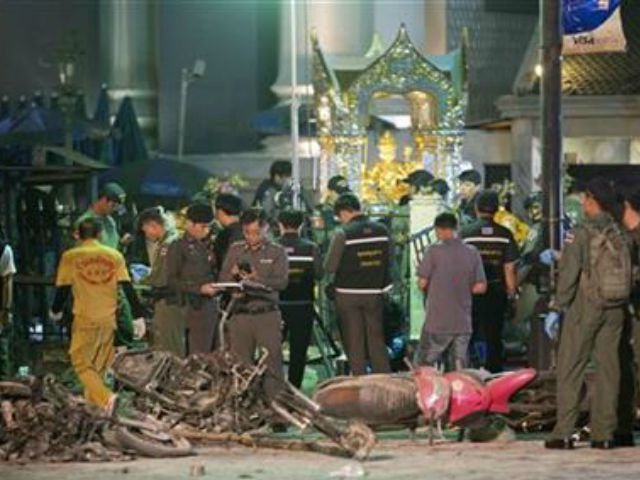As Thai authorities desperately hunt for the terrorists behind the horrible bomb attack on the Erawan shrine in Bangkok, which has killed at least 22 people and wounded over a hundred others, the police have reportedly discovered and deactivated at least two more bombs, while a third explosive device was thrown by an unknown assailant onto a bridge crowded with pedestrian traffic.
Thankfully, the attacker missed, and the bomb ended up detonating in the Chao Phraya river without causing any injuries. If the bomb had landed on target, the loss of life could easily have been on par with the slaughter at the Erawan shrine. The Sydney Morning Herald reports the device was similar to the shrine weapon – described in other media as a pipe bomb – and the pedestrian walkway targeted by the would-be mass murderer is “located near a busy pier where tourists embark on river trips,” near the “luxury Shangrila Hotel.”
The detonation, which understandably sent dozens of people fleeing in terror, was captured by a security camera:
The UK Independent relays reports from Thai media that the police found more explosive devices near the scene of Monday’s deadly blast. “We are now looking for another two to three bombs as we have found one suspicious object,” national police chief Prawut Thawornsiri told reporters. “There could be another explosion, so we have blocked off the crime scene and are asking bystanders to move back.”
Shortly afterward, according to the Independent, police diffused another device. CNN says that some other “suspicious items” reported in the area turned out to be harmless bags of garbage, examined and cleared by police explosives experts.
This could be the bomb a New Zealand paramedic working in Thailand claims to have spotted while helping to tend victims of the attack. Marko Cunningham said he arrived at the scene on his motorcycle, and while returning to his bike after working on some of the victims, he noticed a suspicious bag lying behind a trellis fence. He notified the Thai army at once, and says they confirmed it was a bomb.
“I was so lucky. It’s a big tactic of terrorists to let off a bomb and have emergency services come to the scene before letting off another one,” Cunningham told New Zealand’s Stuff. “I’m just so lucky it didn’t [go off]. Maybe someone higher up was working on our side.”
Cunningham also described the hideous scene that awaited him when he raced to the sound of the explosion: “Everything was shredded, from concrete to bodies, flesh ripped off the bone, absolutely horrific. Those that survived were behind other people, we had to lift dead bodies off bodies to get those who were behind.”
One particular pair of victims haunted him. “The only thing I try not to think about is one couple about 25-years-old who were holding hands, and the guy was alive and his girlfriend was dead,” Cunningham said. “I can’t even imagine sitting next to someone, holding their hand and your alive and they’re dead. It’s really wrong, everything about it is wrong.”
He judged the attack “vindictive and hateful” – not an effort to make a political point, but a bloodthirsty attempt to “kill and hurt as many people as possible.”
Thai Defense Minister Prawit Wongsuwan said the perpetrators “intended to destroy the economy and tourism because the incident occurred in the heart of the tourist district.” The failed bomb attack on pedestrians several hours later would have been consistent with this objective. Many of the victims in the shrine bombing were foreigners visiting or working in Bangkok, including Chinese, Taiwanese, Malaysians, and at least one person from the Philippines.
The intense manhunt for those perpetrators has thus far been unable to identify their organization or purpose. As of Tuesday morning, there had been no official claim of responsibility.
Prime Minister Prayuth Chan-ocha is quoted in the Sydney Morning Herald speculating that the attackers hailed from “an anti-government group based in Thailand’s northeast,” which the Herald describes as “the heartland of the kingdom’s Red Shirt movement that opposes the military junta.”
That coup was executed in May of 2014, and left Thailand’s economy sluggish, except for the vibrant tourist industry. The Wall Street Journal reports that Prayuth has been issuing vague warnings about possible attacks from such a group for several months.
Business Insider mentions a “low-level Muslim insurgency in the predominantly Buddhist country’s south,” in progress for over 10 years, as another possible suspect, but notes “those rebels have rarely launched attacks outside their heartland.” Additionally, the Thai military observed that the southern insurgents are not known for using the type of explosive weapons detonated in Bangkok.
Much attention is currently focused on a suspect captured on closed-circuit TV, a man who carried a rucksack into the shrine area, then departed without it roughly 15 minutes before the explosion. According to the UK Daily Mail, Thai police believe this individual, described as wearing a yellow T-shirt and thick-rimmed glasses, has ties to the aforementioned “anti-government group” in the northeast of the country.
Another person of interest mentioned by police is a woman, said to have been observed placing a bag near the shrine about 15 minutes before the blast. A police officer quoted by the New York Times said she was “overheard speaking Thai.” It seems from news reports on Tuesday morning that police attention is shifting more toward the male suspect, however.

COMMENTS
Please let us know if you're having issues with commenting.